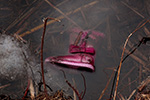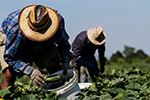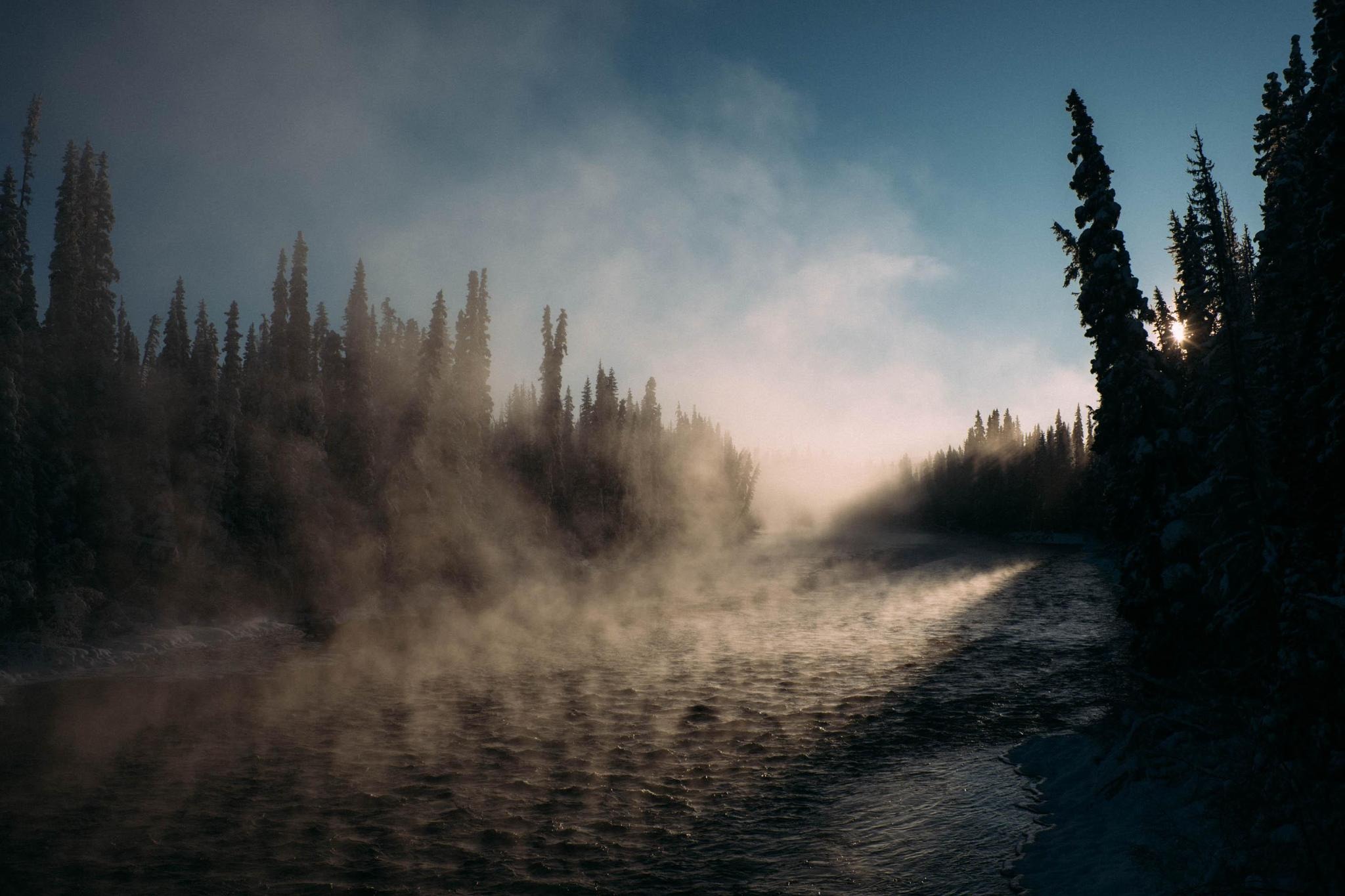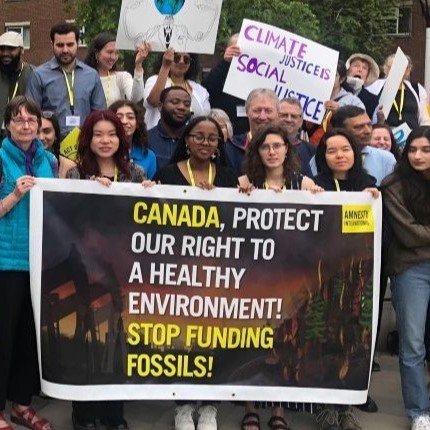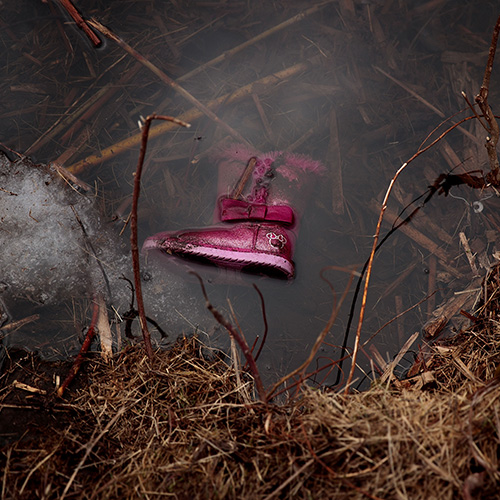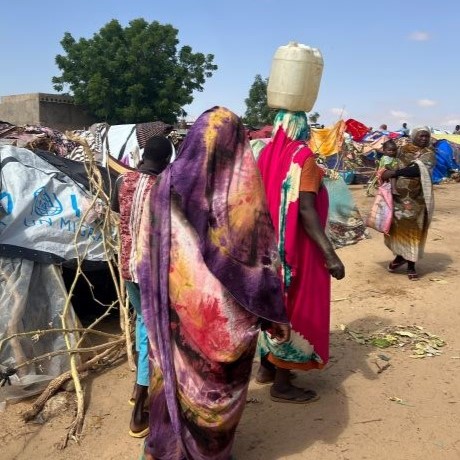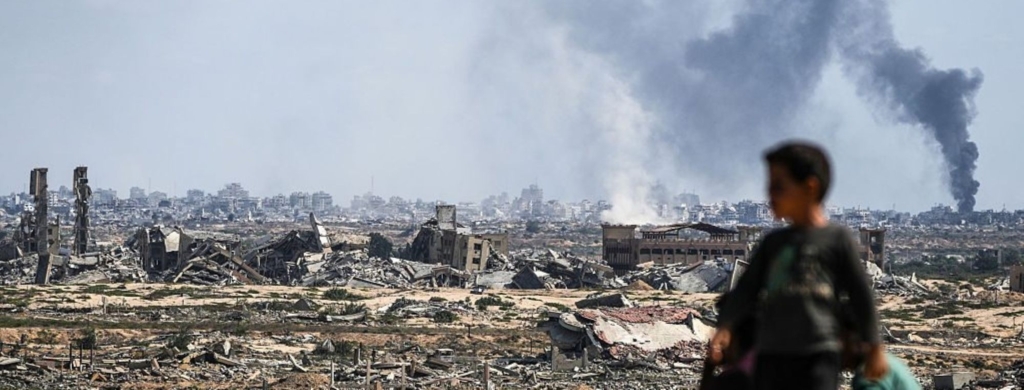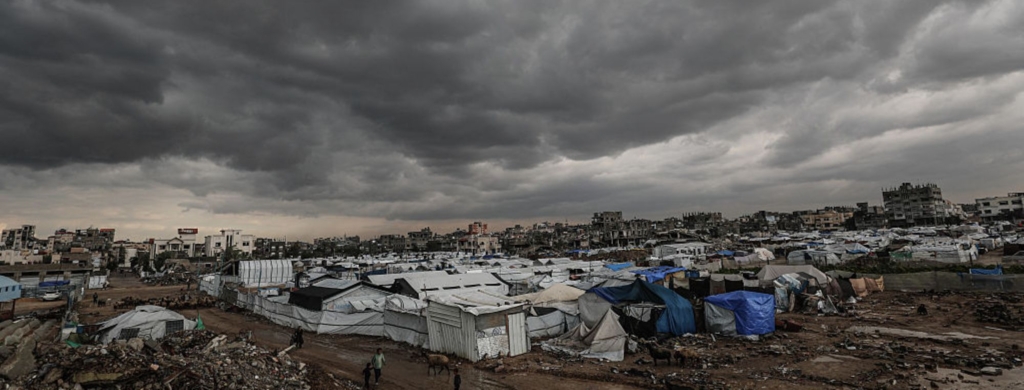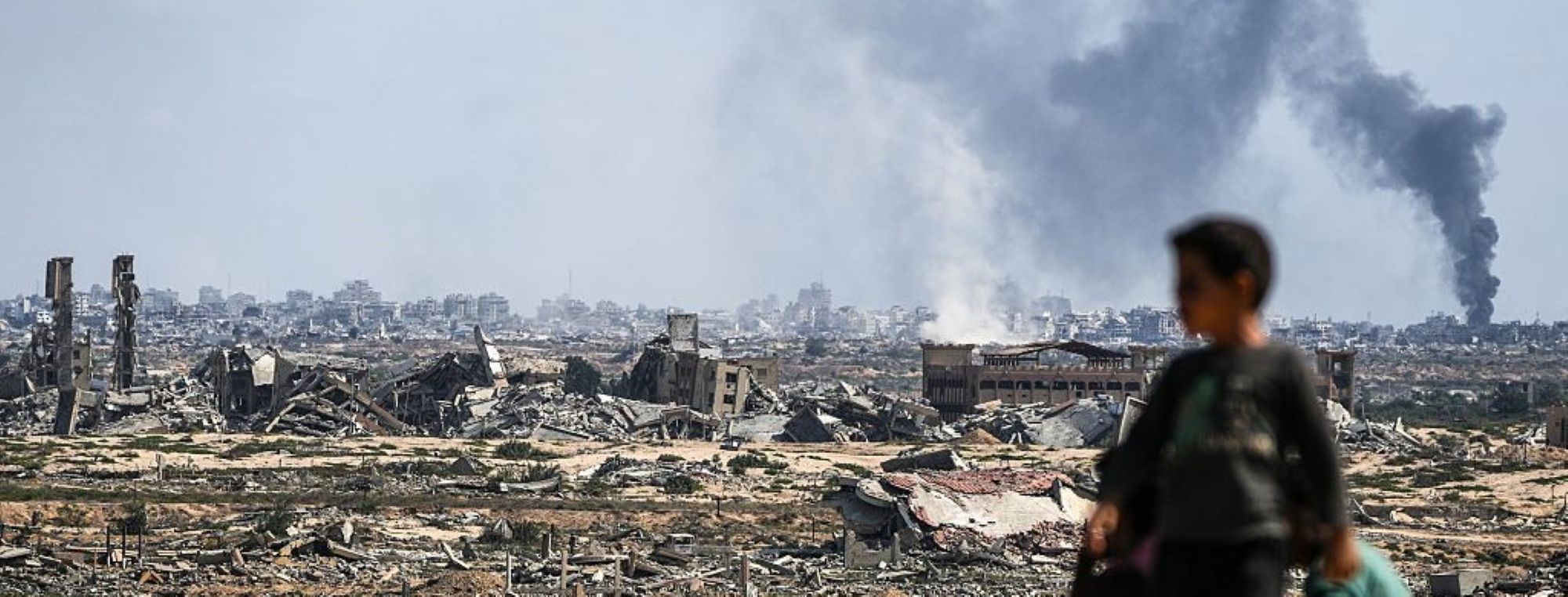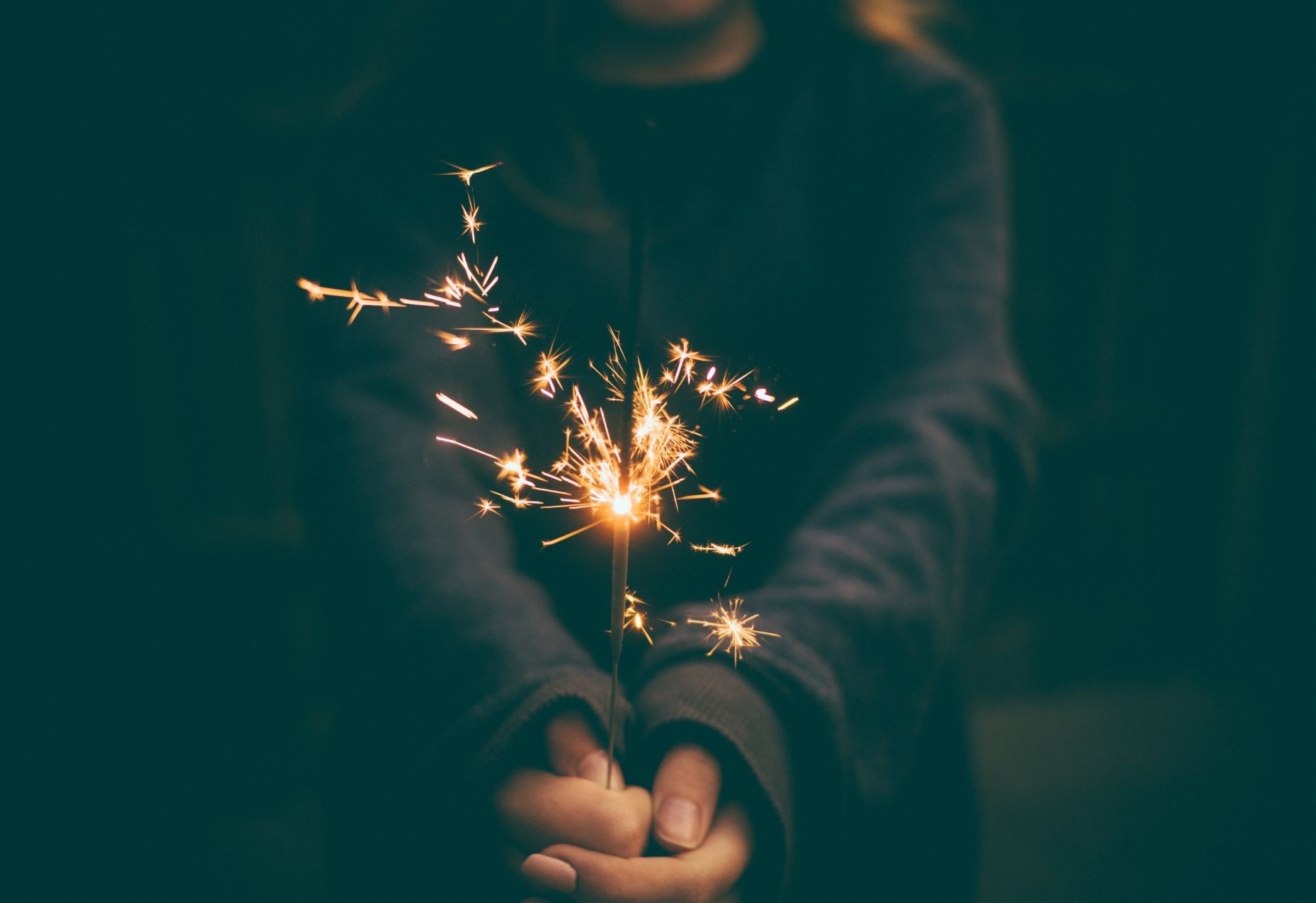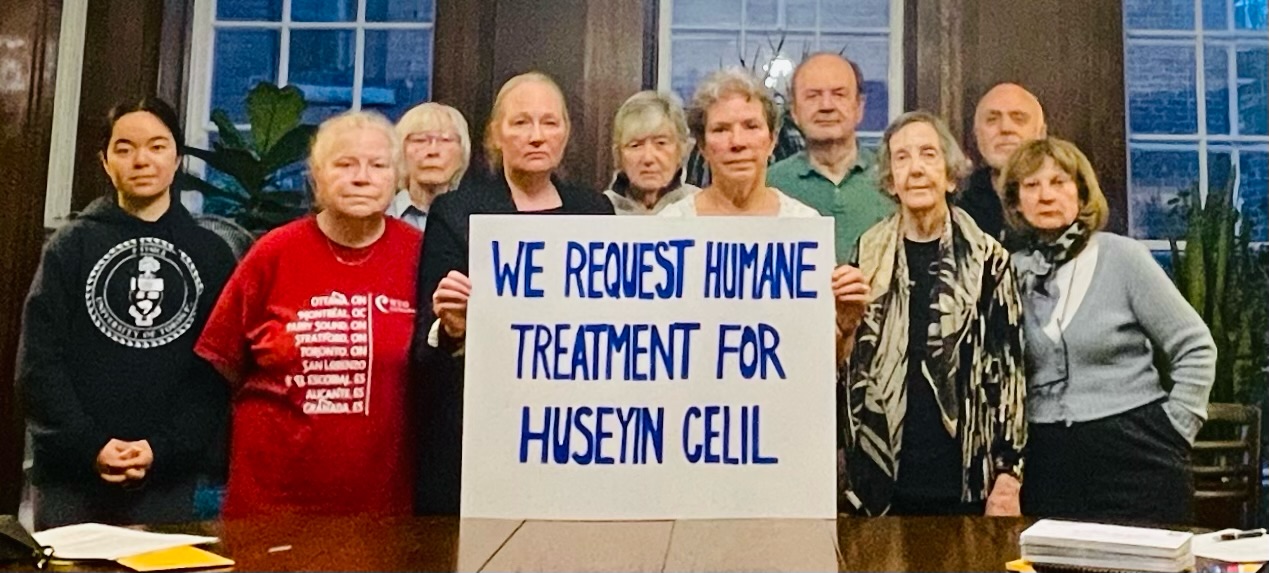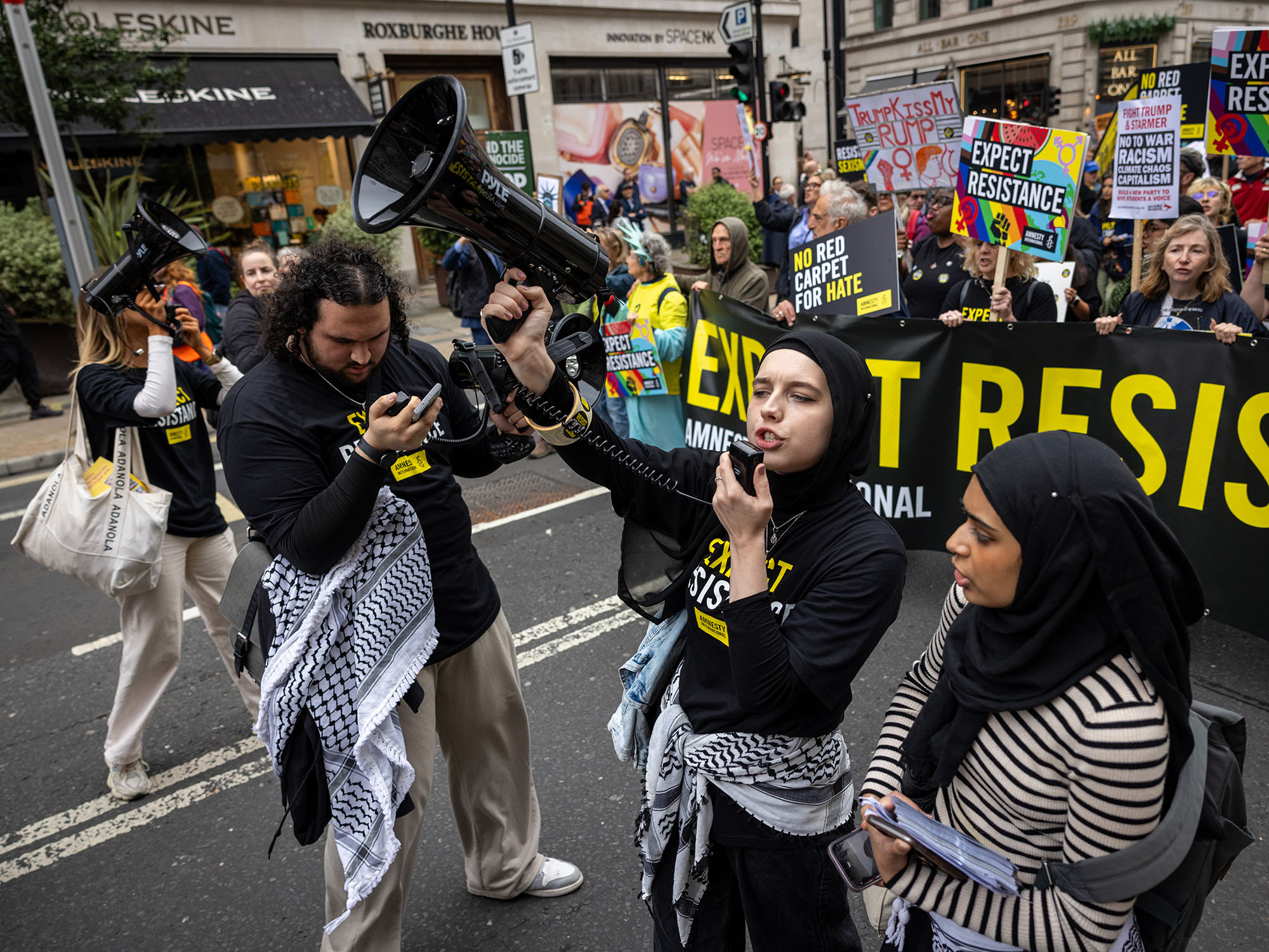Jennifer Wickham is a member of Cas Yikh (Grizzly Bear House) in the Gidimt’en (Bear/Wolf) Clan of the Wet’suwet’en people. She currently lives in Gidimt’en yintah in what is now known as northern British Columbia and is the Media Coordinator for the Gidimt’em Checkpoint. Jennifer is currently co-producing/co-directing the documentary film “Yintah” about the Wet’suwet’en fight for sovereignty. She loves to bead, write and spend time with family. She dreams of freedom for her people and bright shiny futures for all the young people!
Image description: Wedzin Kwa is the river at the headwaters of the salmon spawning channel for all the communities from Wet’suwet’en yintah down to the west coast. She is pure and contains everything needed to sustain life. The Wet’suwet’en people occupying their territory on her banks still drink from her. She is the boundary line between Cas Yikh and Unist’ot’en and they both fight to protect her from Coastal GasLink and other oil and gas pipelines that want to destroy her for profit. Image credit: Michael Toledano.
The Wet’suwet’en people have lived in what is now known as northern British Columbia, Canada since time immemorial. We have governed and maintained 22,000 km2 of land through careful monitoring and through balancing a reciprocal relationship with the land. As a matrilineal society, our governance system is rooted with our women, and it is from our mothers that we get our house membership. Our practice of cultural transmission, which includes our duty to protect the land, was intentionally broken by the government by its forced removal of our people from the yintah (land). All the historic and ongoing violence of colonization has been perpetrated with the singular intention of having unfettered access to our territories and resources. As confirmed in 1997 by the Supreme Court of Canada case, Delgamuukw—Gisdaywa, our rights and title as Wet’suwet’en people have never been extinguished. The day after this decision was announced, the government and industry schemed ways to circumvent the decision in order to ensure their ongoing access to our yintah. As reported by The Narwal:
“Internal emails, memos and confidential briefing notes also show that, immediately after the Delgamuukw decision came down from the Supreme Court of Canada on Dec. 11, 1997, B.C. government officials discussed tactics to fight land rights with legal challenges, to curb direct action or litigation by First Nations and to use federal money intended for the healing of residential school survivors to make treaty negotiations more attractive.“
Today, this violence continues as mega-projects such as gas and oil pipelines are forced onto and throughout our lands as our laws and systems are disrespected, our women are victimized, and as our people are criminalized for upholding Wet’suwet’en laws. In December 2018, Gidimt’en, one of the five clans of the Wet’suwet’en Nation, took control of access to our territory by erecting the Gidimt’en Checkpoint. This was done to stand in solidarity with the Unist’ot’en house group for the protection of our sacred headwaters Wedzin Kwa (also known as the Morice River), our main salmon spawning river with water so pure we still drink directly from it. Since then, the RCMP have organized yearly militarized raids to forcibly remove Wet’suwet’en people from their very own land, including key spokespeople like Sleydo’ Molly Wickham, Gidimt’en clan member, and Howilkit Freda Huson of the Unist’ot’en. This was in direct contravention of the United Nations Declaration on the Rights of Indigenous People, and the UN Committee on the Elimination of Racial Discrimination has issued three letters to Canada addressing these, and other, human rights violations.
Sleydo’ Molly Wickham confronts NAB about its lending to the Coastal Gaslink Pipelinehttps://t.co/10N0WF9X9A
— Gidimt’en Checkpoint (@Gidimten) December 19, 2021
The criminalization of our people goes back to the potlatch ban that was in effect from 1884-1951. During this time, Wet’suwet’en governance practices were outlawed by the Canadian government within the Indian Act. There were many ways the government tried to control and eradicate our ways of life through the Indian Act, including creating the reservation system, imposing the governance of chief and council, creating residential schools, and what has been come to be known as the 60’s Scoop – the intentional and forceful removal of Indigenous children from their families and homes and their placement in predominantly white foster homes without access to their culture. Many of these colonial tactics were rooted in the belief that Indigenous people were barbaric, uneducated, and had no religious beliefs. These beliefs dehumanized Indigenous people and led to legitimize the theft of their land, resources, and children, under the guise of ‘saving them’. In 2008, then PM Stephen Harper delivered an apology to Residential School survivors, stating, “These objectives were based on the assumption Aboriginal cultures and spiritual beliefs were inferior and unequal. Indeed, some sought, as it was infamously said, ’to kill the Indian in the child’.” 14 years on from this formal apology, the same kind of colonial violence that tries to upend our rights, suppress our governance, and menace our community, prevails against us in our daily lives on Wet’suwet’en territory.
Many of the widespread harmful beliefs that were imposed on to our people were also taught to generations of non-Indigenous children. These harmful beliefs have resulted in the systemic failure to end the staggering numbers of missing and murdered Indigenous women and girls in Canada. In particular, there is a highway that runs through Wet’suwet’en territory known as the “Highway of Tears” called so because it is the site of the last known whereabouts of many of our women and girls. The prevalence of industry, transient men, and disposable income increases the risk for the already vulnerable women and girls along the remote stretch of this highway. Studies on the impacts of resource development on our land are explicitly referenced in the National Inquiry into Missing and Murdered Indigenous Women and Girls:
“Expert witnesses, institutional witnesses and Knowledge Keepers told the National Inquiry that resource extraction projects can drive violence against Indigenous women in several ways, including issues related to transient workers, harassment and assault in the workplace, rotational shift work, substance abuse and addictions, and economic insecurity.”
Very recently, a former Coastal GasLink employee filed a lawsuit for sexual battery. The Inquiry specifically recommended:
“We call upon all governments and bodies mandated to evaluate, approve, and/or monitor development projects to complete gender-based socio-economic impact assessments on all proposed projects as part of their decision making and ongoing monitoring of projects. Project proposals must include provisions and plans to mitigate risks and impacts identified in the impact assessments prior to being approved.”
The 231 Calls for Justice still have not fully been implemented and it has taken years for the federal government to create a National Action Plan, all the while our women are still being murdered and going missing. We have received reports of assault and violence from individual Indigenous women who have worked for the Coastal GasLink pipeline within our territories and supported them in their filing of police reports and choices to take action to protect themselves. Turning to the RCMP to report assaults is not a reliable option in Wet’suwet’en territory as RCMP are known to harass and intimidate our women and community members on a daily basis.
Just one example of how everyone on the yintah is harassed and ticketed for not being CGL employees https://t.co/qeWYnMDOsW
— Gidimt’en Checkpoint (@Gidimten) June 17, 2022
Since March 2022, there have been hundreds of visits by the Community-Industry Response Group (a division of the RCMP) who threaten, arrest, intimidate and surveil all persons coming and going from the territory who do not appear to be industry workers. They set up road checks with no clear purpose other than to stop and identify Wet’suwet’en people travelling in their own territory for cultural purposes. They have repeatedly been found idling on the driveway of Sleydo’, Gidimt’en Checkpoint spokesperson’s home and have even gone so far as to shine flashlights through her windows while claiming to be ‘checking in’ on her family’s safety. This kind of blatant harassment has extended to the site of our newest project, the building of a balhats (feast hall) at Tsel Kiy Kwa (Lamprey Creek), an ancient village site that is a physical embodiment of our governance system on the land. It’s clear that these are attempts to suppress our forms of governance, cultural practices, and even frighten our leaders into silence.
The fight for Wet’suwet’en sovereignty continues against the face of colonial violence, with Wet’suwet’en women at the frontlines defending their children’s futures.
TAKE ACTION IN SOLIDARITY WITH WET’SUWET’EN DEFENDERS
- Call on the Minister of Public Safety, Mark Mendicino, and BC Premier John Horgan to comply with the UN Committee to End Racial Discrimination decision and to respect Wet’suwet’en title and rights.
- Read our posts on Fossil Fuels and the Defence of Rights at Risk and the Ongoing Call for Solidarity with Wet’suwet’en Defenders.
- Read our report Out of Sight, Out of Mind, on Indigenous rights and the gendered impacts of resource development.
Guest Essay Series
The final essay in our Pride and Indigenous History Month series will be posted on June 29, 2022.
To read the other essays in this series:
June 1 | On Intersectionality, Access to Justice, and Walking Between Worlds, by Benjamin Vandorpe, Founder, JusticeTrans.
June 8 | LGBTQI+ Afghans Need a Safe Way Out by Kimahli Powell, Executive Director, Rainbow Railroad.
June 15 | Indigenous Women, Girls and Gender-Diverse People Are Humans With Rights by Lynne Groulx, CEO, Native Women’s Association of Canada.
June 21 | Epimotew Tastawayik Niso Askiya – Walking in Two Worlds by Rachel Wuttunee.
June 29 | Queer/Muslim/Canadian by Momin Rahman.










